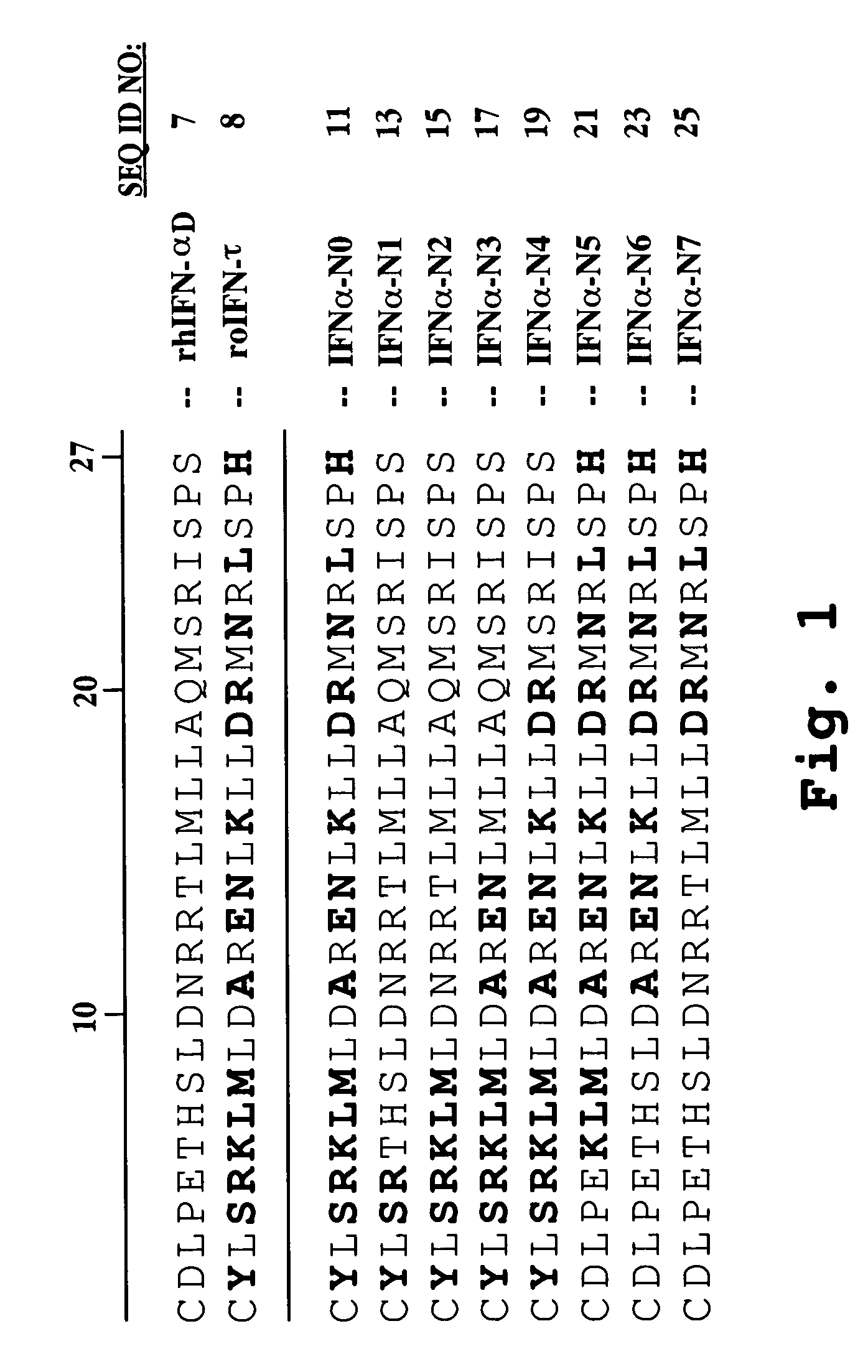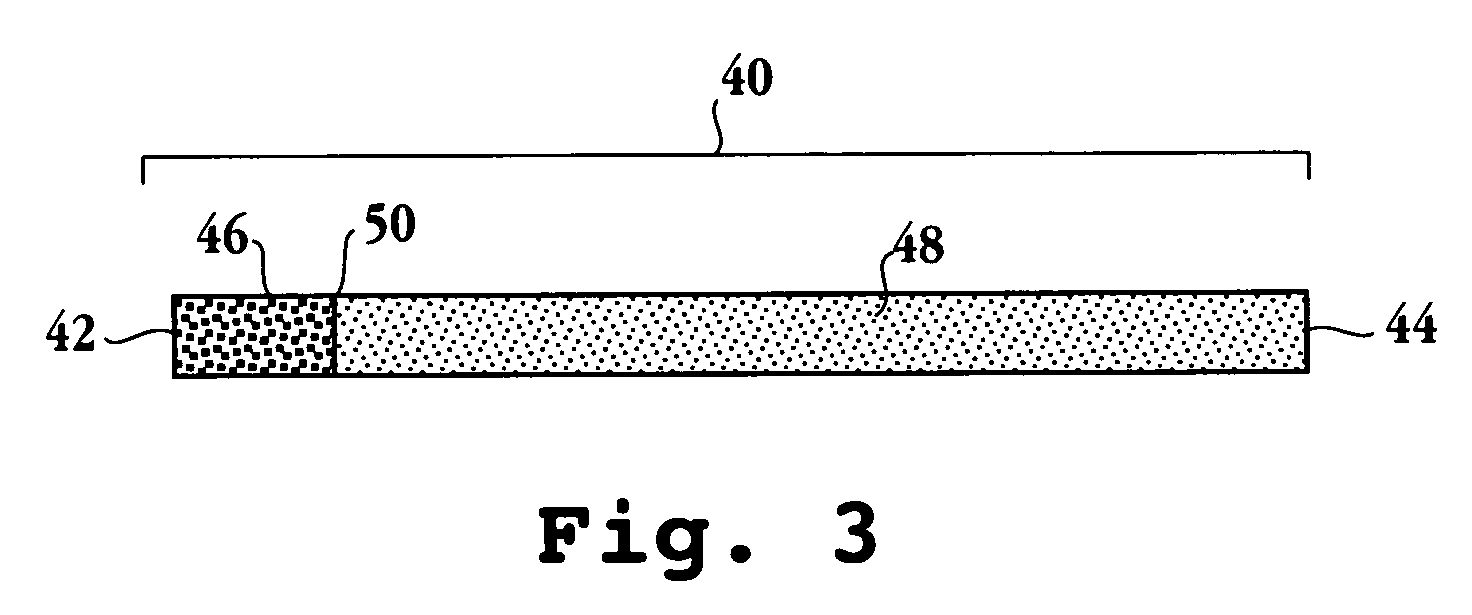Low-toxicity, long-circulating human interferon-alpha PEGylated mutants
a long-circulating, human technology, applied in the direction of peptides, drug compositions, peptides, etc., can solve the problems of abnormal liver function, toxic side effects of patients, etc., and achieve the effect of no cytotoxic effect on hepatocytes
- Summary
- Abstract
- Description
- Claims
- Application Information
AI Technical Summary
Benefits of technology
Problems solved by technology
Method used
Image
Examples
example 1
Synthesis of IFNα Analogs and Pegylated-IFNα-N7
A. Preparation of IFNα Protein Analogs Based on Native Human IFNαD
[0144]A synthetic gene encoding a human IFNα protein analog, termed HuIFNα-NLV, was constructed by first backtranslating the amino acid sequence of HuIFNαcontaining 15 interferon-tau (IFNτ) amino acid substitutions within the first 27 N-terminal positions with codon usage optimized for Pichia pastoris. The nucleotide sequence was edited to include five restriction sites spaced throughout the length of the construct. The synthetic gene sequence was divided into four nucleotide fragments. The individual fragments, each approximately 150 base pairs in length, were constructed by sequential ligations of oligonucleotides. The fragments were sequentially cloned into the G2 bacterial vector (Operon Technologies, Alameda, Calif.) to yield the gene encoding HuIFNα-N0 (see FIG. 1). The synthetic gene was then cut out of the bacterial vector and ligated into the XhoI / NotI sites of t...
example 2
In Vitro Antiviral Activity of Pegylated-IFNα2b-N7
[0150]The antiviral activity (Units / mL) of IFNα2b-N7 (SEQ ID NO:48) and PEG (40 kDa)-IFNα2b-N7 (PEG modified SEQ ID NO:48, prepared as described in Example 1C) was determined and compared to the antiviral activity of IFN-α2b (Intron A®) and the pegylated IFNα2a product identified by the tradename Pegasys®, using an assay based on the Madin Darby bovine kidney (MDBK) cell line and the vesicular stomatitis virus (VSV) as the challenge virus.
[0151]The antiviral potency of the interferons was assessed by testing the protective effect of the interferon on MDBK cells against VSV. Dilutions of the interferons were added to confluent MDBK cell monolayers, grown in 96-well flat bottom plates, and incubated for 18 hrs prior to addition of the virus challenge. Recombinant human IFN-αA (Biosource International, Camarillo, Calif.) was used as the standard interferon control for the assay. Dilutions of each interferon sample were assayed to obtain...
example 3
In Vitro Antiproliferative Activity of Pegylated-IFNα2b-N7
[0155]The in vitro anti-proliferative activity of PEG (40 kDa)-IFNα2b-N7, prepared as described in Example 1C, was compared with the anti-proliferative activity of the pegylated IFNα product identified by the tradename Pegasys®. Seven human tumor cell lines representing major neoplastic categories were cultured and treated with the interferons. The magnitude of cell proliferation was measured by the reduction of the tetrazolium salt WST-1. The degree of reduction of WST-1 of the interferon treated cells was compared to non-treated control cells.
[0156]The results are shown in Table 2. The anti-proliferative activity of PEG (40 kDa)-IFNα2b-N7 and Pegasys® were similar in the seven cell lines tested.
[0157]
TABLE 2Comparison of interferon anti-proliferative activity inhuman tumor cell linesaCell LineCell Line OriginPEG-IFNα2b-N7Pegasys ®ACHNRenal cell48 + / − 442 + / − 3CRL-1611adenocarcinomaDLD-1Colorectal72 + / − 763 + / − 2CCL-221adeno...
PUM
| Property | Measurement | Unit |
|---|---|---|
| molecular weight | aaaaa | aaaaa |
| molecular weight | aaaaa | aaaaa |
| molecular weight | aaaaa | aaaaa |
Abstract
Description
Claims
Application Information
 Login to View More
Login to View More - R&D
- Intellectual Property
- Life Sciences
- Materials
- Tech Scout
- Unparalleled Data Quality
- Higher Quality Content
- 60% Fewer Hallucinations
Browse by: Latest US Patents, China's latest patents, Technical Efficacy Thesaurus, Application Domain, Technology Topic, Popular Technical Reports.
© 2025 PatSnap. All rights reserved.Legal|Privacy policy|Modern Slavery Act Transparency Statement|Sitemap|About US| Contact US: help@patsnap.com



